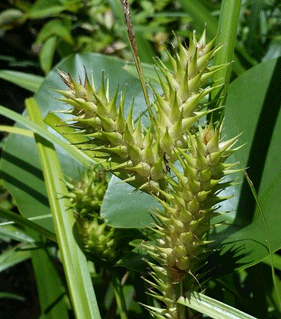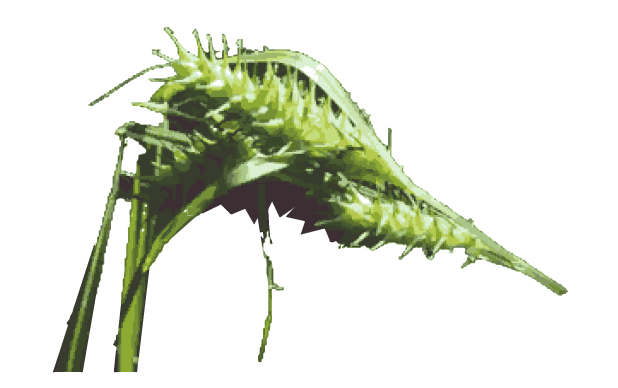False Hop Sedge

Species information
The following is a report on progress made towards the protection and recovery of False Hop Sedge (Carex lupuliformis) in Ontario from 2007 to 2022, based on Ontario’s species-specific recovery policy. This report meets the legislative requirement for a review of progress under the Endangered Species Act, 2007 (ESA or “the Act”). False Hop Sedge is listed as endangered on the Species at Risk in Ontario (SARO) List under the ESA.
False Hop Sedge has been classified as a species at risk since 2004. It was originally classified as an endangered species and was listed as such under the ESA when it came into force in June 2008.
False Hop Sedge has been protected from being killed, harmed, harassed, captured or taken since 2004.
In addition, the habitat of False Hop Sedge has been protected from being damaged or destroyed since 2008.
The species-specific recovery policy for False Hop Sedge, known as the Government Response Statement (GRS) was published in 2018 and includes the government’s recovery goal for the species and the actions and priorities it intends to lead or support to help achieve that goal. The GRS considers science advice provided in the recovery strategy (published in 2017), such as species biology, habitat needs, threats to survival, knowledge gaps and approaches to recovery, when developing recovery actions for the species. As legislated in the Act, the purpose of this Review is to report on progress made towards implementing the protection and recovery actions in the GRS. The review can also help identify opportunities to adjust and adapt the implementation of protection and recovery actions to achieve the recovery goal for the species.
Further information about False Hop Sedge, including the threats that it faces, and actions being taken to help protect and recover this species is available on the Government of Ontario webpage for False Hop Sedge. A summary on the progress towards the protection and recovery of False Hop Sedge and an annual update on the broader species at risk program (i.e. the Introduction to the 2023 Review of Progress report) is available on the Review of Progress towards the Protection and Recovery of Ontario’s Species at Risk webpage.
Snapshot: Progress towards the protection and recovery of False Hop Sedge
Progress towards meeting the recovery goal
- The recovery goal in the Government Response Statement (GRS) for False Hop Sedge in Ontario is “to maintain the Ontario distribution of the species and support the persistence of self-sustaining populations. The government supports investigating the feasibility of augmenting existing populations.”
- Progress has been made towards implementing all of the government-led actions. Progress has been made towards implementing one of the government-supported recovery objectives and two of the associated actions. Examples of progress include:
- Developing and implementing a standard monitoring protocol for the collection of data in Ontario
- Developing and implementing a standard presence survey protocol to survey additional areas identified as having suitable habitat and potential for additional populations
- In alignment with the GRS, further work is required to:
- Conduct research to determine specific site conditions optimal for the health and sustainability of False Hop Sedge, including amount of canopy openness and soil moisture
- Study the species’ population dynamics and structure
- Develop, implement and evaluate the effectiveness of habitat management techniques to maintain or improve the quality of habitat available for False Hop Sedge
Occurrences and distribution:
- Nineteen populations of False Hop Sedge have been documented in SouthernOntario. Currently, sixteen of these populations are extant, whereas the remaining three are considered historical or possibly extirpated. Since 2008, the status of one population changed from extant to historical based on the date that it was last observed. No populations changed from historical to extant; however, three were reconfirmed extant through survey efforts after a period of 16 to 17 years. Eleven populations of False Hop Sedge have been newly identified since 2008.
- Since 2008, the Natural Heritage Information Centre (NHIC) has received over 58 records of the species based on observations made between 1902 and 2022.
Government-supported stewardship projects:
- Through the Species at Risk Stewardship Program, the Government of Ontario has enabled its stewardship partners to conduct two projects (by providing $93,865 in funding) that have supported the protection and recovery of multiple species at risk, including False Hop Sedge. One of these projects was designed to provide benefits to multiple species at risk (e.g., landscape-level habitat restoration projects, outreach and education focusing on a certain group of species such those present in a region), while the other project focused exclusively on False Hop Sedge.
- The government’s support helped its stewardship partners to involve 45 individuals who volunteered 212 hours of their time towards protection and recovery activities for species at risk, including False Hop Sedge. The estimated value of these voluntary contributions, as well as additional funding and in-kind support, is $92,116.
Supporting human activities while ensuring appropriate support for species recovery:
- Three agreements were entered into for False Hop Sedge. These agreements were enabled through Ontario Regulation 242/08 (prior to the July 1, 2013 amendment).
- Twelve activities have been registered for the species. The activities were registered under‘ecosystem protection’ (section 23.11), ‘possession for educational purposes, etc.’ (section 23.15), ‘species protection, recovery activities’ (section 23.17), and ‘threats to health and safety, not imminent’ (section 23.18)under Ontario Regulation 242/08 of the ESA.
Reporting on the progress towards the protection and recovery of False Hop Sedge
Recovery Goal
The government’s goal for the recovery of False Hop Sedge is to “maintain the Ontario distribution of the species and support the persistence of self-sustaining populations. The government supports investigating the feasibility of augmenting existing populations.
The implementation of government-led and government-supported actions demonstrates progress towards reaching the desired objectives and the recovery goal set out in the GRS.
Progress towards implementing government-led actions
Progress has been made towards implementing all government-led actions identified in the GRS. Common actions for the government to lead as it works towards achieving a species’ recovery goal include:
- Continuing to implement the Ontario Invasive Species Strategic Plan to address the invasive species (e.g., Reed Canary Grass, Common Buckthorn) that threaten False Hop Sedge.
- Educating other agencies and authorities involved in planning and environmental assessment processes on the protection requirements under the ESA.
- Encouraging the submission of False Hop Sedge data to the Ministry’s central repository at the Natural Heritage Information Centre.
- Undertaking communications and outreach to increase public awareness of species at risk in Ontario.
- Continuing to protect False Hop Sedge and its habitat through the ESA.
- Supporting conservation, agency, municipal and industry partners, and Indigenous communities and organizations to undertake activities to protect and recover False Hop Sedge. Support will be provided where appropriate through funding, agreements, permits (including conditions) and/or advisory services.
- Encouraging collaboration, and establish and communicate annual priority actions for government support in order to reduce duplication of efforts.
Ontario’s Invasive Species Strategic Plan
The GRS for False Hop Sedge indicates that invasive species (e.g., Reed Canary Grass (Phalaris arundinacea) and European Buckthorn (Rhamnus cathartica)) pose a threat to the survival and recovery of the species in Ontario. The Ontario Invasive Species Strategic Plan, 2012 provides a policy framework to prevent new invaders from arriving and surviving in Ontario, to slow and where possible reverse the spread of existing invasive species, and to reduce the harmful impacts of existing invasive species, including impacts on species at risk. This framework may support the implementation of actions to reduce the threats from invasive species.
Occurrences and distribution
Nineteen populations of False Hop Sedge have been documented in Ontario. Sixteen are considered to be extant
Eleven populations of False Hop Sedge have been newly identified since 2008, five of them since 2018. One population is believed to have been extirpated between 2003 and 2006. One population that was considered to be extant in 2008 is presently considered to be historical. Three populations were reconfirmed extant in 2021 or 2022 after a period of 16 to 17 years.
The newly identified populations were detected by biologist doing professional consulting, conducting wetland evaluations for the Ministry of Natural Resources and Forestry and participating in a Field Botanists of Ontario field trip. They are likely the result of increased search effort and education about False Hop Sedge and likely do not represent actual population increases, but rather increased knowledge about the distribution of the species.
It is possible that there are observations of False Hop Sedge that have not been submitted to the government. Encouraging the submission of observations of this species is included in the GRS as a government-led action. Submission of species observations increases our knowledge of where they occur and can play an important role in assessing the viability of species populations.
Everyone is encouraged, or may be required by an authorization or approval to submit observations of False Hop Sedge, and any other species at risk observed, to the NHIC for incorporation into the provincial record of observations.
-
58observations of this species were submitted to the NHIC since 2008.
Government-supported stewardship projects
An important government-led action in the GRS for False Hop Sedge is to support partners to undertake activities to protect and recover the species. Through the Species at Risk Stewardship Program the government has supported two projects ($93,865) designed to contribute to the protection and recovery of False Hop Sedge or multiple species at risk, including False Hop Sedge. One of these projects was designed to provide benefits to multiple species at risk (e.g., landscape-level habitat restoration projects, outreach and education focusing on a certain group of species such those present in a region), while the other project focused exclusively on False Hop Sedge.
In addition to the government funding, partners focusing exclusively on False Hop Sedge and projects designed to benefit multiple species at risk, including False Hop Sedge reported they were successful in securing additional funding ($92,116) from other sources. These amounts include in-kind support in the form of time and expertise provided by volunteers. Stewardship partners reported that provincial funding helped them to secure in-kind support by involving 45 individuals who volunteered 212 hours of their time towards protection and recovery activities that focused exclusively on False Hop Sedge and activities for multiple species at risk, including False Hop Sedge, which has an estimated value of $4,600.
The remainder of this section highlights a project supported through the Species at Risk Stewardship Program as well as the corresponding government-supported recovery actions for the species.
The project undertaken by North-South Environmental Inc. from 2021 to 2022 advanced progress on government-supported actions to develop and implement a standard presence survey protocol and monitoring protocol for False Hop Sedge. The protocols were developed on the basis of a literature review and expert consultation during the first stage of the project, then field tested in Southern Ontario during the second stage. Field testing was completed at 16 locations, five of which were known to previously support populations of False Hop Sedge. At the location of one of these populations, in the City of London, it was determined that False Hop Sedge had been extirpated. A subdivision has been constructed where the population was documented. False Hop Sedge was not found at two other locations in the City of London where it has been observed in the past and may also be extirpated from them. Excessive shading from increased shrub cover was observed at one location and altered drainage from ditch construction was observed at the other. In contrast, False Hop Sedge populations were confirmed extant at two of the locations where they have been previously found in Elgin County. Based on population size monitoring results, the size of one of these populations was found to be sufficient to prevent the loss of genetic fitness in the short term. However, the size of the other population was found to be far less than is needed to support genetic fitness and demographic viability. During 2021, a specimen of False Hop Sedge from a previously undocumented population was examined by North-South Environmental Inc. ecologists when made available by another environmental consulting company. Although the location of the population was considered confidential and therefore was not disclosed, it represents the second known occurrence in Oxford County.
-
 1
1project including False Hop Sedge
-
 1
1project for False Hop Sedge exclusively
-
 $93,865
$93,865for projects that included False Hop Sedge
-
 $92,116
$92,116in additional funding and in-kind support
-
 45
45volunteers
-
 212
212volunteer hours
Supporting human activities while ensuring appropriate support for species recovery
Supporting partners through authorizations and their associated conditions is an important government-led action. To date, no permits have been issued for False Hop Sedge.
Three agreements were entered into for False Hop Sedge. These agreements were enabled through Ontario Regulation 242/08 (prior to the July 1, 2013 amendment). Conditions of the agreements involve implementing actions in the mitigation plan, including, but not limited to:
- Limiting equipment access and operations to the side of the drainage works that will minimize disturbance where False Hop Sedge occurs
- Locating temporary storage sites for excavated sediments or bank materials on areas of open soil away from where any of the False Hop Sedge is likely to occur
- Not using any broad-spectrum herbicides in areas where additional mitigation measures are required to be undertaken for False Hop Sedge
Twelve activities that may affect False Hop Sedge or its habitat have been registered for the purposes of Ontario Regulation 242/08: ‘General’ under the ESA. One activity was registered under ‘ecosystem protection’ (section 23.11), one under ‘possession for educational purposes, etc.’ (section 23.15), two under ‘species protection, recovery activities’ (section 23.17), and seven under ‘threats to health and safety, not imminent’ (section 23.18). These registrations require the registrant to comply with all conditions of the regulation, such as:
- Giving the Ministry of the Environment, Conservation and Parks notice of the activity before it commences
- Having a mitigation plan prepared by a person with expertise on False Hop Sege to facilitate avoidance or minimization of adverse effects on False Hop Sedge while the activity is carried out
- Taking reasonable steps to minimize adverse effects on False Hop Sedge while carrying out the activity
-
3agreements
-
12registrations
Progress towards implementing government-supported actions
Government-supported actions are organized under overarching recovery objectives. Progress has been made towards achieving one government-supported recovery objective and implementing two of the associated actions identified in the GRS for False Hop Sedge.
Objective: Increase knowledge of the distribution, abundance and habitat conditions of False Hop Sedge in Ontario.
- Actions No. 5 (High Priority) – Develop and implement a standard monitoring protocol for collection of data in Ontario, including;
- monitoring population size and extent, including the number of naturally occurring and previously transplanted individuals, and monitoring the seed bank
- monitoring productivity and plant health
- monitoring canopy openness, soil moisture, and any additional threats to the species (e.g., parasite presence)
- Action No. 6 – Develop and implement a standard presence/absence survey protocol to survey:
- additional areas identified as having suitable habitat and the potential for additional populations
- site where the species historically occurred and there is the potential for plants to remain (e.g., Amherstburg)
Under this objective, initial progress has been made towards implementing both actions.
Both actions have been implemented through a project supported by the Species at Risk Stewardship Program, which is highlighted in the section on government-supported stewardship projects above.
Summary of progress towards meeting the recovery goal
The recovery goal for False Hop Sedge is “to maintain the Ontario distribution of the species and support the persistence of self-sustaining populations. The government supports investigating the feasibility of augmenting existing populations.” Effort made towards the government-led and government-supported actions has helped to make progress towards this goal. For example, by having supported efforts to document the presence of populations of False Hop Sedge, and develop a protocol for that purpose, the government is better positioned to maintain them. Three populations were reconfirmed extant since the protocol was completed.
Recommendations
As stated in the GRS, this review of progress can be used to help identify whether adjustments to the implementation of GRS actions are needed, to achieve the protection and recovery of the species. Based on progress to date, the overall direction provided in the GRS for False Hop Sedge, particularly the implementation of actions identified as high priority, should continue to guide protection and recovery of the species.
Although initial progress has been made towards the actions to develop and implement presence survey and monitoring protocols, further work is required to fully implement this action. Monitoring of False Hop Sedge population health and demographic change, habitat and threats, and the development of a protocol for absence surveys, are needed.
While there has been much focus on the progression of other actions, the following actions require additional support to aid the protection and recovery of the species:
- Action No. 1 (High Priority) - Conduct research to determine specific site conditions optimal for the health and sustainability of False Hop Sedge, including the amount of canopy openness and soil moisture
- Action No. 2 (High Priority) - Study the species’ population dynamics and structure, including:
- the viability of seeds in the soil and factors that influence germination
- rates of maturation and seed production
- the method of seed dispersal and how it influences the structure of False Hop Sedge populations (e.g., interactions between populations, demographics)
- genetic aspects that may limit the species (e.g., inbreeding)
- conduct a population viability analysis to determine the minimum viable population sizes of False Hop Sedge
- Action No. 3 - Study the species’ ability to adapt to ecological conditions (e.g., availability of light, frequency and length of flooding events)
- Action No. 4 - Investigate the feasibility of augmenting existing populations that are at risk of extirpation, where sufficient suitable habitat is available for the species
- Action No. 7 - Develop, implement and evaluate the effectiveness of habitat management techniques to maintain or improve the quality of habitat available for False Hop Sedge. Plans may include practices such as:
- removal of invasive plants (e.g., Reed Canary Grass and Common Buckthorn), woody vegetation and other plants that directly compete with False Hop Sedge at existing sites
- canopy thinning, as appropriate, and if evaluated to be beneficial for the species
- Action No. 8 - Implement approaches to avoid or reduce the impacts of recreational activities on False Hop Sedge and its habitat, including:
- redirecting recreational activities away from the species
- erecting physical barriers, while ensuring that the barriers will not lead to the establishment of woody vegetation
- installing signage to alert people to the presence of the species
- Action No. 9 - Promote awareness among landowners, land managers, and land users about False Hop Sedge, including information on:
- how to identify the species
- the species’ habitat requirements
- protection afforded to the species and its habitat under the ESA
- actions that can be taken to reduce threats to the species and its habitat
Protecting and recovering False Hop Sedge will continue to be a shared responsibility that will require the involvement of many individuals, organizations and communities. Financial support for the implementation of actions may be available through the Species at Risk Stewardship Program. The government can also advise if any authorizations under the ESA or other legislation may be required to undertake a project. By working together, progress can continue to be made towards protecting and recovering False Hop Sedge in Ontario.
Footnotes
- footnote[1] Back to paragraph A population is considered extant if it has been observed within the last 20 years or an appropriate interval for the species in question. Extant populations may have been extirpated, particularly if observations are not recent and updated information is unavailable.
- footnote[2] Back to paragraph A population is considered historical if it has been the object of several appropriate surveys and has not been detected within the last 20 years or an appropriate interval for the species. Alternatively, it is considered historical if it has not been the object of appropriate surveys and either is at a location where general habitat loss or degradation is known to have occurred or it has not been observed in 40 or more years. Historical populations may still exist, but updated information is unavailable.